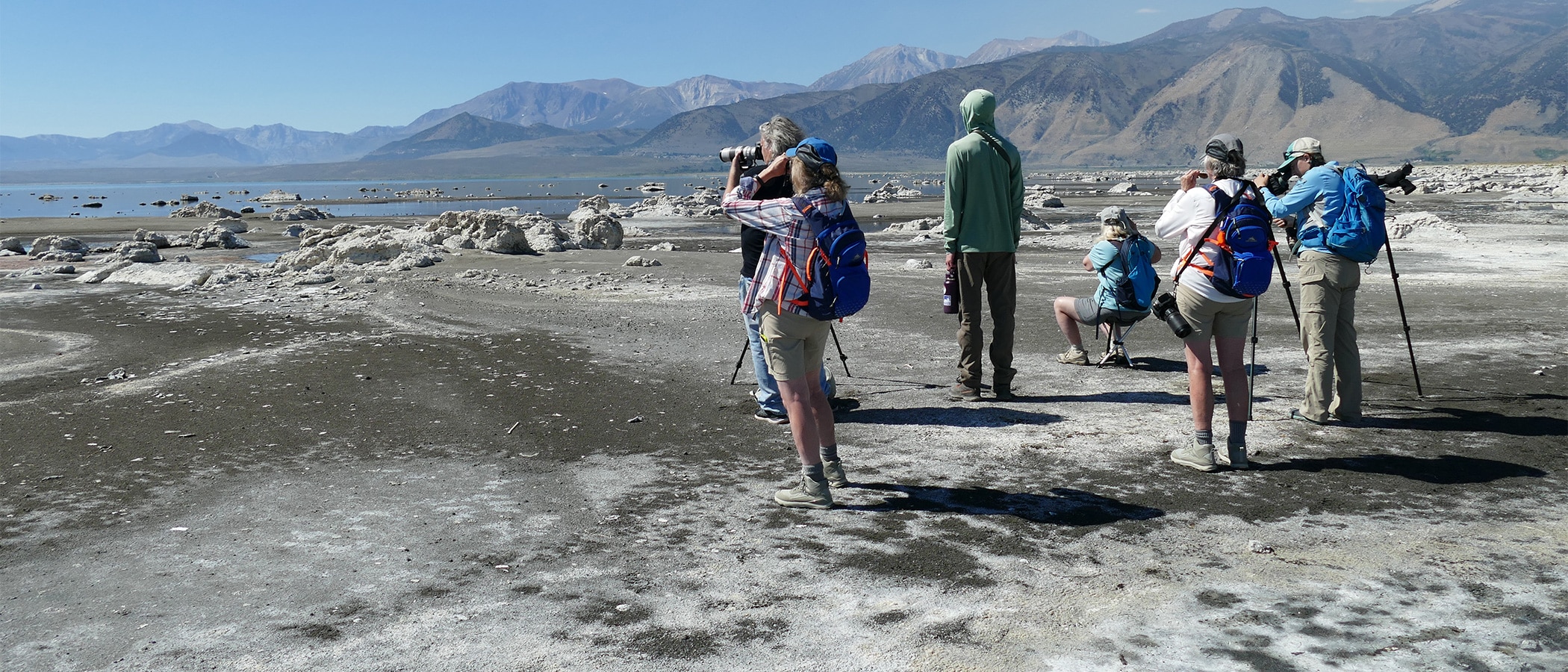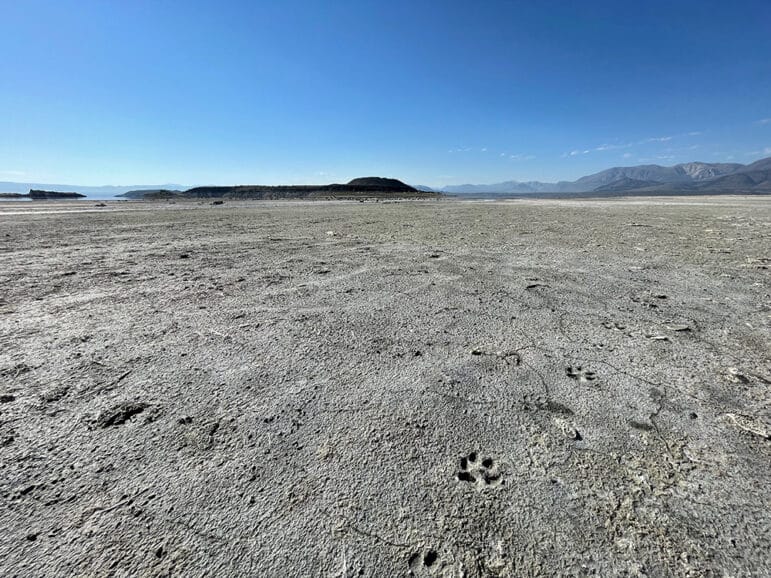
Purpose: Raise Mono Lake to the Public Trust lake level of 6392 feet
With Mono Lake painfully low, talk has been frequent in recent months about the California State Water Resources Control Board’s future hearing on the matter.
A hearing is required because the State Water Board itself set forth the requirement within the water rights of the Los Angeles Department of Water & Power (DWP). The Board stated it “will hold a hearing” if the lake did not rise to the mandated protection level by September 28, 2020. Unfortunately, the lake was only 30% of the way to the requirement on that date, and is even lower today.
There’s no question that a hearing is in the future. So what will the hearing take a look at? And when will it happen?
Lake protection is settled
The State Water Board’s first Mono Lake hearing was decades ago—longtime members and Mono Lake supporters remember those 1993–94 proceedings well. Many people turned out for public comment forums around the state, and the hearing itself journeyed through the seasons with over 40 days of testimony and cross examination. The transcripts exceeded 30,000 pages.
The Board had a big job to accomplish and compelling legal and scientific reasons to spend so much time on its intensive effort.
First, the Board had to determine the streamflows necessary to protect fish in order to resolve violations of State Fish & Game codes and meet court requirements for Mono’s tributaries.
And second, it had to determine the lake level necessary to protect the Public Trust resources of Mono Lake for the people of California, as required by the state Supreme Court ruling won by the Committee and our partners at Audubon in 1983.
The Board summarized those Public Trust resources to be:
“…air quality in the Mono Basin; water quality in Mono Lake; the Mono Lake brine shrimp and brine fly which provide food for migratory birds; secure, long-term nesting habitat for California gulls and other migratory birds; easily accessible recreational opportunities for the large number of visitors to the Mono Lake Tufa State Reserve; and the panoramic and scenic views which attract many people to the Mono Basin.”
The Board’s rigorous analysis led to the landmark protection of Mono Lake in 1994. “This decision,” it wrote, “amends Los Angeles’s water right licenses to include specified water diversion criteria which are intended to gradually restore the average water elevation of Mono Lake to approximately 6,392 feet above mean sea level in order to protect Public Trust resources at Mono Lake.”
The protective 6392-foot lake level goes by many names: the State Water Board mandate, the management level, the ecologically healthy level, and more. Recognizing its roots in the state’s obligation to balance LA’s water supply with protecting Mono Lake for future generations, we also call it the Public Trust lake level.
Focus on stream diversion rules
The problem facing Mono Lake today is that the water diversion criteria established in 1994 haven’t raised the lake to 6392 feet on the 20-year schedule expected by the Board. In fact, 28 years later, the lake is only 25% of the way there. The stream diversions allowed by these criteria, and taken by DWP, have significantly slowed the lake’s progress in rising toward the Public Trust lake level. The hearing could change these rules.
The diversion criteria are familiar to Mono Lake enthusiasts: no stream diversions when the lake is below 6377 feet; 4,500 acre-feet of diversions in years like this one when Mono Lake is between 6377 and 6380 feet; and up to 16,000 acre-feet allowed when the lake is above 6380 feet. But what we now understand in this era of drier conditions is that the fixed water diversion amounts that have given DWP more than 381,000 acre-feet of Mono Basin surface water since 1994 have held back the lake’s recovery. If DWP had not diverted that water, Mono Lake would be almost seven feet higher than it is today, and in much better shape for wildlife, birds, nesting California Gulls, and clean air.

And so the topic of the future hearing will be, put simply: What new water diversion criteria will get the job done? In fact, this is the reason the State Water Board planned to have a hearing in the first place, writing in 1994 that the Board was “keenly aware of the limitations of computer modeling hydrologic systems and the probability that future hydrologic conditions may differ significantly from historical conditions.”
The Board’s plan was designed to adapt to changing conditions—if the lake didn’t rise on schedule, that would be a sign that hydrologic conditions had varied from expectations, and a hearing would take place. And at the hearing, “the [Board] could adjust the water diversion criteria in an appropriate manner under the exercise of its continuing authority over water rights.”
One thing we do not expect the hearing to include is consideration of lowering the Public Trust lake level. The extensive Public Trust analysis and supporting science was completed in the 1994 decision and the biology of brine shrimp and needs of nesting gulls, to name just a couple of considerations, remain the same—there would be no basis for reopening that determination.
No date on the calendar, yet
The hearing is required because on September 28, 2020, the date specified by the State Water Board, the lake surface elevation was below the Public Trust lake level (more than ten feet below, and has fallen farther since then). But the question of when, exactly, the hearing will take place is currently unanswered.
Hearings take time to schedule and staff and financial capacity to run. Most likely a dozen or more parties—the Committee, state agencies, the regional air quality regulator, Mono Lake Kootzaduka’a Tribe, DWP, and more—will show up with attorneys in tow, meaning it is a very large undertaking. On the other hand, it will not be nearly as extensive as the original proceedings because the topic is limited to the stream diversion rules.
As the lake lingers at low levels it is no surprise that low lake problems are generating concern. This summer the Great Basin Unified Air Pollution Control District wrote to the State Water Board, requesting the hearing be scheduled soon in light of the serious air quality violations caused by dust storms from the exposed lakebed. “Measurements of PM10 [particulates] at the District’s Mono Shore monitoring station, located on the northeast shore of Mono Lake, are some of the highest PM10 concentrations in the United States,” the District wrote, noting that raising the lake to the Public Trust lake level is “the only feasible solution to controlling the windblown dust at Mono Lake.”
The Mono County Board of Supervisors sent a letter in the early fall requesting the hearing be scheduled, and the Kootzaduka’a Tribe is drafting a letter of concern as well.
The Committee’s own letter on the hearing reviews the record surrounding the hearing requirement and documents the intended hearing focus on modifying stream diversion rules to ensure Mono Lake rises to the Public Trust lake level. The Committee has been preparing for the hearing for years, notably by modernizing our hydrologic model of the lake in anticipation of the need to quickly and accurately evaluate the effectiveness of new stream diversion concepts.
Fortunately this year, under the existing rules, the low lake caused stream diversions to be automatically reduced, providing some respite for Mono Lake. The Mono Lake Committee will continue to engage with the State Water Board on the hearing in the months ahead, and at the same time we are working on collaborative water solutions for Los Angeles.
We will be keeping members and friends updated about the progress toward the hearing; keep an eye here on the blog for the most current news.
This post was also published as an article in the Fall 2022 Mono Lake Newsletter. Top photo by Emma Rosen: The rules for stream diversions established by the State Water Board in 1994 haven’t allowed Mono Lake to rise to the healthy Public Trust lake level on the expected 20-year schedule.
